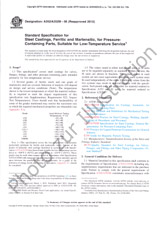Wir benötigen Ihre Einwilligung zur Verwendung der einzelnen Daten, damit Sie unter anderem Informationen zu Ihren Interessen einsehen können. Klicken Sie auf "OK", um Ihre Zustimmung zu erteilen.
ASTM E2350-19
Standard Guide for Integration of Ergonomics/Human Factors into New Occupational Systems
Name übersetzen
NORM herausgegeben am 15.8.2019
Informationen über die Norm:
Bezeichnung normen: ASTM E2350-19
Anmerkung: UNGÜLTIG
Ausgabedatum normen: 15.8.2019
SKU: NS-968566
Zahl der Seiten: 9
Gewicht ca.: 27 g (0.06 Pfund)
Land: Amerikanische technische Norm
Kategorie: Technische Normen ASTM
Kategorie - ähnliche Normen:
Die Annotation des Normtextes ASTM E2350-19 :
Keywords:
ergonomics, human factors, occupational system, process design, work, work evaluation,, ICS Number Code 03.100.30 (Management of human resources),13.180 (Ergonomics)
Ergänzende Informationen
| Significance and Use |
|
5.1 Integrating ergonomic principles into new occupational systems may help businesses develop processes that do not exceed worker capabilities and limitations. 5.2 Jobs and tasks that conform to worker capabilities and limitations may be performed more efficiently, safely, and consistently than those that do not. 5.3 The application of ergonomic principles to the processes involved in occupational systems may help avoid system failures and inefficiencies. 5.4 The integration of ergonomic principles at the earliest stages of process concept and design may facilitate appropriate design, layout, and allocation of resources and may reduce or eliminate the necessity for later redesign that could have been foreseen. 5.5 Designing jobs that fit the capabilities of larger population segments may increase an organization's accessibility to the available labor pool. 5.6 The integration of ergonomic principles into occupational systems may increase profit by lowering direct and indirect costs associated with preventable losses, injuries, and illnesses. 5.7 The bibliography contains a list of reference materials that may be useful in particular applications. All appendixes are nonmandatory. |
| 1. Scope |
|
1.1 This guide is intended to assist in the integration of ergonomic principles into the design and planning of new occupational systems from the earliest design stages through implementation. Doing so may reduce or eliminate the necessity for later redesign that could have been foreseen. 1.2 This standard does not purport to address all of the safety concerns, if any, associated with its use. It is the responsibility of the user of this standard to establish appropriate safety, health, and environmental practices and determine the applicability of regulatory limitations prior to use. 1.3 This international standard was developed in accordance with internationally recognized principles on standardization established in the Decision on Principles for the Development of International Standards, Guides and Recommendations issued by the World Trade Organization Technical Barriers to Trade (TBT) Committee. |
Empfehlungen:
Aktualisierung der technischen Normen
Wollen Sie sich sicher sein, dass Sie nur die gültigen technischen Normen verwenden?
Wir bieten Ihnen eine Lösung, die Ihnen eine Monatsübersicht über die Aktualität der von Ihnen angewandten Normen sicher stellt.
Brauchen Sie mehr Informationen? Sehen Sie sich diese Seite an.




 Cookies
Cookies
